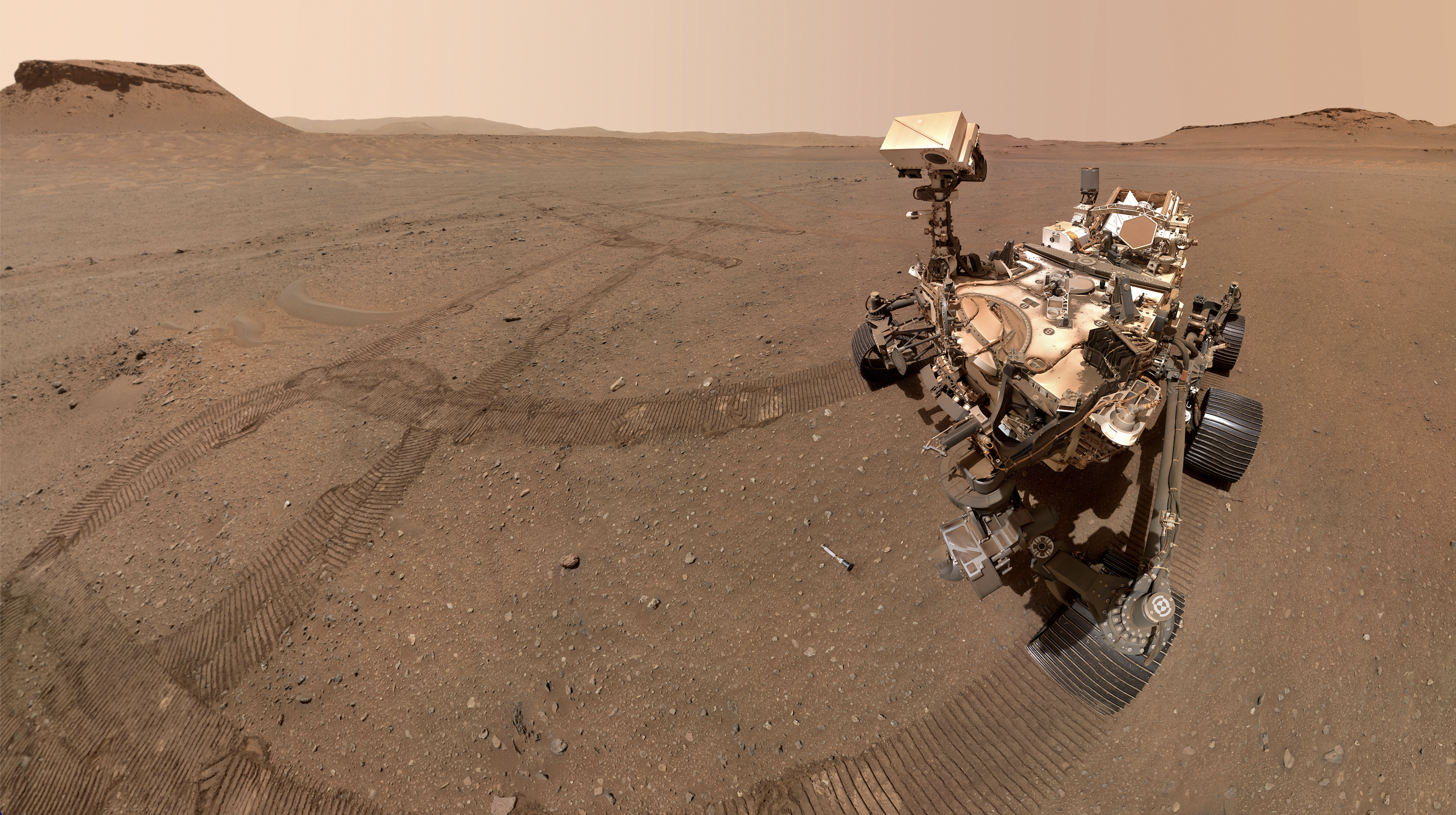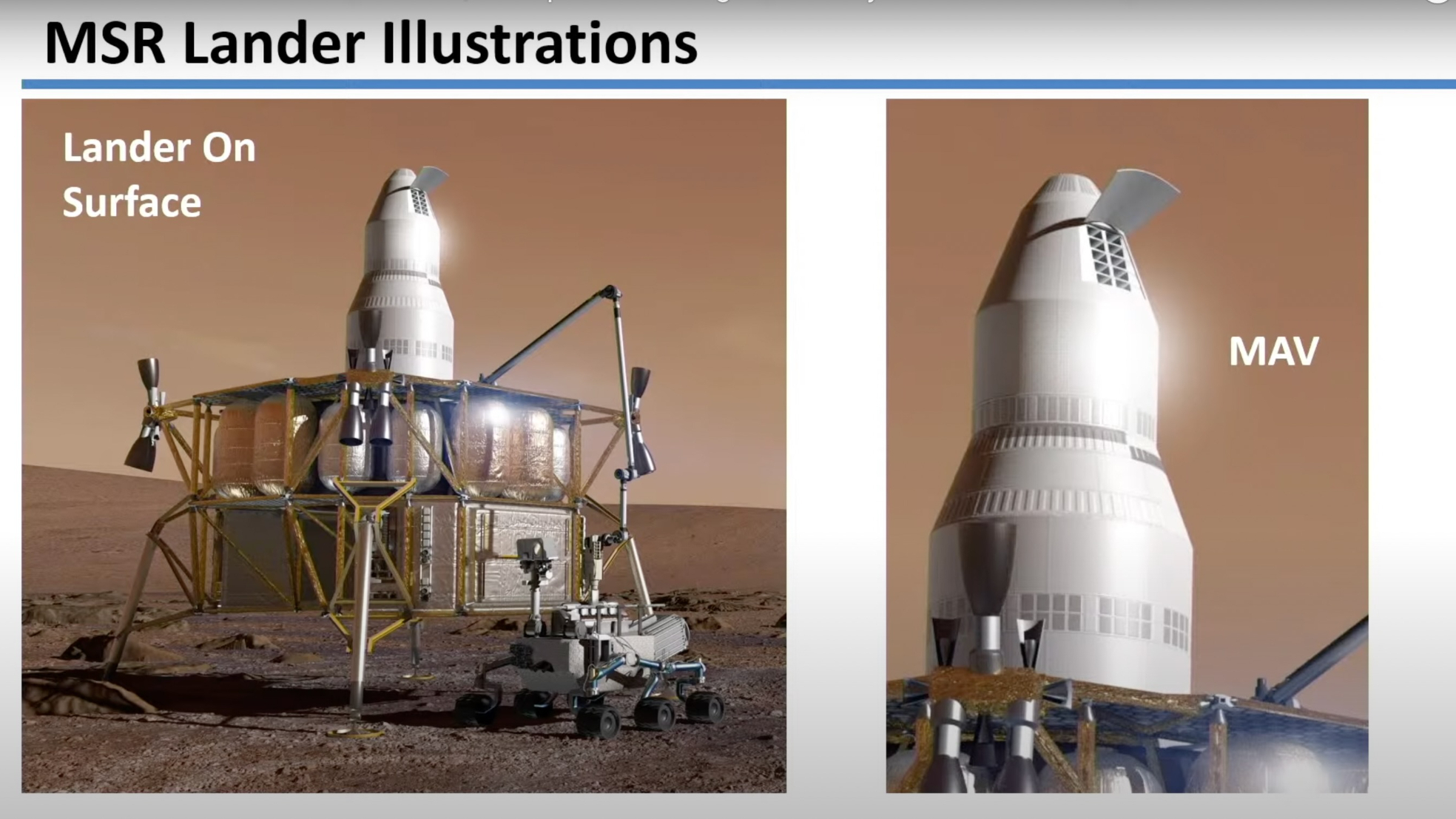NASA's Mars sample return mission is in trouble. Could a single SLS megarocket be the answer?
NASA could get Mars samples back to Earth with a single launch of the Space Launch System rocket, Boeing says.

Boeing has put forward its own idea to help NASA get its Mars Sample Return project back on track and on budget.
NASA issued a solicitation for new ideas to get scientifically invaluable Martian material to Earth after being told the current plan is too expensive (about $11 billion), while also being too complex and facing scheduling issues.
Former NASA Chief Scientist Jim Green presented Boeing's vision for a rejiggered Mars sample return mission concept at the annual Humans to Mars Summit last week.
Related: NASA's Mars Sample Return in jeopardy after US Senate questions budget
The concept centers on using NASA's Space Launch System (SLS) rocket, for which Boeing is a lead contractor. The giant rocket, which performed well during its first, and so far only, flight — the Artemis 1 moon mission in late 2022 — could carry all the hardware needed to pull off an ambitious, multi-spacecraft Mars sample return mission, according to Green.
"So, to reduce mission complexity — one of the top things NASA wants to do — this new concept is doing one launch," he said in his presentation.
NASA's previous plan envisioned multiple launches to place a Mars Ascent Vehicle (MAV) on the Martian surface, grab samples collected by the agency's Perseverance rover and return them to Earth. Boeing's single-shot concept would put a lander on Mars, with the help of an entry and descent aeroshell and a descent module with retro rockets, that could do all the work needed to get the precious samples home.
Get the Space.com Newsletter
Breaking space news, the latest updates on rocket launches, skywatching events and more!
Boeing's proposed plan includes a fetch rover to retrieve Perseverance's samples. A two-stage MAV with a sample canister and an encapsulation system would be able to reach Mars orbit and then fire its engines to head home, instead of performing a Mars orbit rendezvous and docking with a transfer vehicle as in the original concept.
Ars Technica noted that, while attempting to cut costs, the use of the giant SLS would itself be expensive; a single launch would likely cost $2 billion at least. Contrary to Boeing's larger-MAV approach, NASA's initial re-thinking seemed to lean toward a smaller and cheaper MAV, and perhaps collecting fewer than the initially planned 43 sealed titanium tubes containing samples collected by Perseverance.

NASA is accepting proposals through May 17 and will begin charting a new path forward on MSR later in the year.
The MSR project remains a high priority for NASA, agency administrator Bill Nelson said last month when announcing the project revamp.
Green noted that returning samples before potential human missions is crucial for understanding the Martian environment, including soil toxicity and resource availability.
Join our Space Forums to keep talking space on the latest missions, night sky and more! And if you have a news tip, correction or comment, let us know at: community@space.com.

Andrew is a freelance space journalist with a focus on reporting on China's rapidly growing space sector. He began writing for Space.com in 2019 and writes for SpaceNews, IEEE Spectrum, National Geographic, Sky & Telescope, New Scientist and others. Andrew first caught the space bug when, as a youngster, he saw Voyager images of other worlds in our solar system for the first time. Away from space, Andrew enjoys trail running in the forests of Finland. You can follow him on Twitter @AJ_FI.
-
Galacsi Nobody talks anymore of danger to the Earth biosphere from theses martian samples.Reply
So I ask a question : There has not been any danger from the start because there is no life on Mars, only equations to be solved, or the danger has disappeared ? Can you explain please. -
Wolfshadw Dangers still exist. We just don't know.Reply
To my understanding, anything collected and returned to Earth (either from the Moon, Mars or an asteroid) is immediately classified as highly dangerous and placed into our highest level HAZMAT quarantine facility until deemed safe for our biosphere. Whether that is safe enough for humanity, again, we don't know.
Ideally, sample returns would actually be captured by the crew of the ISS or some other orbiting platform and be thoroughly tested as a Bio-hazard before being returned to Earth.
-Wolf sends -
Mergatroid ReplyGalacsi said:Nobody talks anymore of danger to the Earth biosphere from theses martian samples.
So I ask a question : There has not been any danger from the start because there is no life on Mars, only equations to be solved, or the danger has disappeared ? Can you explain please.
When the moon samples were returned to Earth, they were vetted, and the astronauts were quarantined for a while as well.
All this has been thought of before hand. -
Torbjorn Larsson Outstanding questions:Reply
Which SLS version can deliver 25 mt to TMI? Current SLS block 1 can deliver 20 mt to TMI. https://ntrs.nasa.gov/api/citations/20205007434/downloads/SLS-PlanetaryDecadal-FINAL-LRP1 091420.pdfIs a 25 mt Mars EDL possible? Current massive lander was 1/10th that or a 2.4 mt EDL stage. https://en.wikipedia.org/wiki/Mars_Science_LaboratoryBoeing seems silent on their plan illustration including a Mars fetch rover mission.So far, relying on Perseverance for sample transport to MAV and a landed Starship craning down the current - or cheaper - MAV seems the ideal cheap mission for NASA. It would help SpaceX plans too. ESA can pay for the orbiter return stage. -
Torbjorn Larsson Reply
There is an ongoing discussion within astrobiology, mainly because planned Mars crew missions means putting a huge source of contamination there.Galacsi said:Nobody talks anymore of danger to the Earth biosphere from theses martian samples.
So I ask a question : There has not been any danger from the start because there is no life on Mars, only equations to be solved, or the danger has disappeared ? Can you explain please.
As for the dangers to Earth biosphere - or vice versa - they are likely low since populations are adapted to their current environment. Of course there will be adaptive encroachment eventually, but e.g. disease risks are unlikely. (Assuming there is still martian life, the separate evolutionary trees would have different metabolic and genetic machinery.)
I don't know what you mean by implying your personal lack of information of the current astrobiology research means there would never have been any risks or they have disappeared, or with suggesting "equations" for areas which are heavily leaning on observations (biology, medicine). But aside from the potential risks the main concern is with contaminating Mars science, since e.g. organics or organisms will dilute, bias or destroy the sample record. Hence (alongside with not taking undue risks) the care with which return samples have to be handled. E.g. the probes and especially their chutes have long been allowed to transfer millions of bacterial spores to Mars surface. The radiative, oxidative environment will kill off the spores eventually.
When ExoMars will drill below the crustal "kill zone" down to 2m, it will be the first time we can contaminate Mars likely habitable environment (wet subsurface strata).
Not really, based in part on the lunar experience the current planetary protection protocols are both more lenient and insufficient for future missions.Mergatroid said:When the moon samples were returned to Earth, they were vetted, and the astronauts were quarantined for a while as well.
All this has been thought of before hand.









